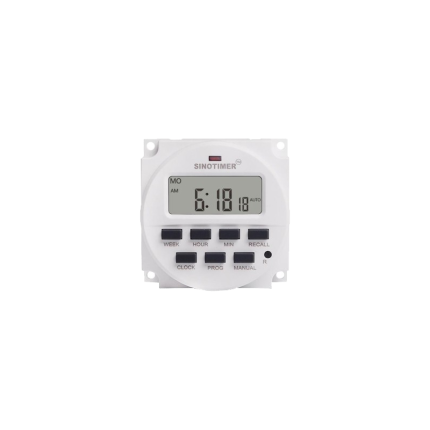Ship or pick up from our office.
Digital programmable ON/OFF relay
A digital programmable ON/OFF relay is an electronic switch that can be programmed to turn electrical devices on or off at specific times or intervals. It combines the fundamental switching functionality of a traditional relay with the advanced timing and control capabilities of a digital timer or microcontroller.
This allows for automated control of various devices and systems without constant human intervention.
How it Works
At its core, a digital programmable ON/OFF relay operates similarly to a standard relay by using a small electrical current to control a larger electrical circuit. However, the "digital programmable" aspect introduces a sophisticated timing mechanism.
- Digital Interface: Unlike mechanical or analog timer relays with physical dials, digital programmable relays feature an LED or LCD display and a keypad or buttons for programming. This allows users to set precise ON/OFF times, durations, and sequences.
- Microcontroller-Based: Most digital programmable relays use a microcontroller to manage the timing and control logic. This internal "brain" keeps track of time and executes the programmed instructions.
- Timing Functions: These relays offer a wide range of timing functions, including:
- On-delay: The relay turns on after a preset delay once activated.
- Off-delay: The relay turns off after a preset delay once deactivated.
- Interval timing: The relay stays on for a specific duration after activation.
- Cyclic operation: The relay repeatedly cycles ON and OFF at set intervals.
- Astronomic timing: Some advanced models can turn devices on/off based on sunrise and sunset times by calculating the solar position.
- Photocell integration: Others may include light sensors to activate based on ambient light levels.
- Memory Retention: Many programmable relays can store settings in memory even after a power interruption, ensuring that the programmed schedule is not lost.
Key Features and Advantages
- Programmable Timing: Offers precise control over when devices turn on and off.
- Automation: Reduces the need for manual operation, leading to increased efficiency.
- Energy Savings: Allows for optimization of energy usage by ensuring devices are only active when needed.
- Flexibility and Versatility: Can be configured for a wide array of applications due to various timing modes.
- Compact Design: Often more compact than systems using multiple hardwired timers and relays.
- Ease of Use: User-friendly interfaces for setting up programs.
- Reliability: Many are solid-state, meaning they have no moving parts, which increases durability and reduces noise compared to electromechanical relays.
Applications
Digital programmable ON/OFF relays are highly versatile and found in numerous applications across various sectors:
- Home Automation: Controlling lighting, appliances, or other devices based on a preset schedule (e.g., security lights, garden irrigation).
- Industrial Automation: Managing machinery, conveyors, pumps, motors, and other equipment in factories or manufacturing facilities.
- Building Management Systems: Automated control of HVAC systems (heating, ventilation, air conditioning), lighting (e.g., streetlights turning on at dusk), and security systems.
- Commercial Applications: Used in vending machines, amusement equipment, and commercial appliances.
- Agriculture: Controlling irrigation pumps or greenhouse lighting.
- Security Systems: Activating alarms or security lights at specific times or in response to sensors.










